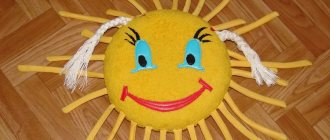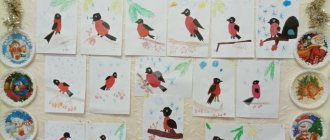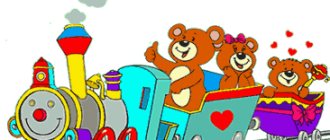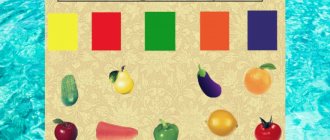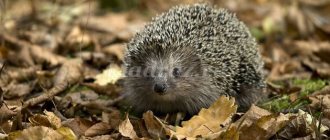Features of modeling in the preparatory group
Types of sculpting:
- subject - a generalized image of the characteristic features of individual objects (duck, owl, crow, etc.);
- plot - a composition of several objects and objects, an artistic embodiment of episodes from fairy tales, literary works (K. Ushinsky “Cockerel with his Family”) or scenes from the surrounding life (“Cockerel with a Hen”, “Hen with Chicks”), practiced only in the older and preparatory groups;
- decorative - a plastic embodiment of the image of a cockerel and a hen in the style of traditional techniques of folk decorative art according to a sketch independently prepared by the child using bright, rich painting (geometric or plant patterns), for example the Filimonovskaya toy, or additional materials (beads, feathers, buttons, shells, seeds ) as an original decoration of the product.
Examples of plot compositions on the theme “Cockerel with his family”
"Cockerel with his family on a walk"
“Cockerel and Hen” modeling in the tradition of the Filimonovskaya toy
"Filimonov family"
"Chicken in a cozy nest"
“Easter chicken” made from salt dough
"Naughty cockerels"
Much attention is paid to collective modeling, thanks to which children develop the skills of coordination of actions, teamwork, improve the psycho-emotional qualities of solidarity, and demonstrate feelings of camaraderie and responsibility. When performing a collective composition, the teacher divides the children into subgroups of four to five people and gives them different tasks, for example, one group sculpts cockerels, another - hens, a third - chickens, a fourth - invents and makes decorations.
Examples of collective work
Examples of various tasks on the topic “Cockerel with his family”
"The chicken went out for a walk"
"Filimonovskie cockerels"
"The Cockerel Family"
Technical types of modeling:
- Constructive - with this method, an image is created by combining and connecting different parts or parts as elements of a constructor. A child masters this technique at the age of two or three, inventing a model and its components.
- Sculptural - modeling from a single piece of material, the child kneads and gives the necessary shape, fashioning an image from a shapeless piece, using a whole arsenal of auxiliary small finger movements: stretches the shape of a beak or tail, crushes it to form wings, twists, pinches, conveying the texture of the surface, presses and etc.
- Combined - a large form is sculpted in a sculptural way, for example, the body, and parts and details (wings, tail, beak, eyes) are attached separately using the molding method. In older preschool age, children prefer this particular option for creating products.
- Modeling using a ready-made form - a thin cake of rolled material is wrapped around a durable form (jar, bottle), the excess is removed, and the seams are smoothed. If necessary, carefully remove the frame form. In this topic, this method is most often used to form the body of a cockerel or chickens.
- Modular modeling - a product is created by constructing from ready-made identical elements (modules), for example, balls, flagella, plates, according to the principle of a volumetric mosaic.
Equipment and tools:
- frames (sticks of different lengths and thicknesses), which are used as load-bearing rods or fasteners for parts or parts of a figure;
- stacks - pointed, rounded, as well as in the form of a spatula and a loop of sticks, used to remove excess clay, make cuts for paws or wings and work out details and texture (feathers, eyes, beak) using drawing and strokes;
- special boards, the size of which depends on the size of the figure (for a figure of 15x20 cm, a board of 22x35 cm is suitable) or rotary machines.
Special boards are usually used for modeling
Characteristic features of modeling work for older preschoolers:
- The desire to more accurately convey the shape of an object, to complement it with secondary details (decorative decorations, external interior or scenery for a plot composition), to depict it in motion.
- Independent selection of an episode, implementation of work planning.
- A wide range of techniques and materials used (clay, plasticine, dough).
- The works of children of senior preschool age embody a generalized image that conveys the vivid characteristics of an object without deep specification and elaboration of details.
Basic skills and knowledge acquired by six-year-old children at previous stages and options for their further development:
- Ability to distinguish and sculpt the shapes of a ball, cylinder, cone and disk.
- In the preparatory group, children are taught to convey the ratio of quantities (more or less), compare similar objects, create compositions (“Mischievous cockerels”, “Chicken in a cozy nest”, “Chickens for a walk”) from painted clay or colored plasticine and place them on stand.
- Use of the tape method of attaching a tape-shaped base to a base, techniques of pressing and pulling, pinching, mastered in the senior group, studying the method of circular molding. These fine hand techniques are especially in demand in the decorative sculpting process.
- Modeling of birds, animals, toys in the style of folk crafts, for example, a Dymkovo toy, from a single piece by drawing out individual parts or parts; later, children are shown options for sculpting individual parts of a bird figure (head and body from a cone or cylinder, flat modeling of wings) and their connections.
Children with interest not only sculpt a folk toy, but also decorate it with original ornaments.
Modeling techniques for the composition “Cockerel with his family”
According to the Federal State Educational Standard, the topics of modeling lessons are repeated annually, but differ in the level of complexity of techniques for making crafts. Children 6–7 years old:
- develop the skill of turning “sausages” into flagella, for example, to show the feathers on the tail of a rooster;
Children of the preparatory group learn to convey the plot in the poses and movements of the figures
- improve the skill of forming “peas” from “balls” for the eyes of birds;
- practice the skill of smoothing seams when pinching parts, for example, a neck with a head and torso;
- learn to pull back plasticine to get pointed elements, for example, a rooster's beak;
- reinforce the skill of creating identical parts in shape and size, for example, bird wings;
- choose the colors of plasticine for the figures themselves;
Using certain shades of plasticine, children should rely on a familiar image: fairy-tale or real
- They use stacks to give the elements of the craft a relief.
Organization, structure and methodology of the lesson
Approximate general education programs for preschool educational organizations focus on a half-hour duration of continuous classes in the preparatory group with breaks for physical education (finger, breathing, motor gymnastics) of 3–5 minutes. Modeling classes are recommended to be held once every two weeks.
Organization and preparation for the lesson.
Children prepare the workplace independently, i.e., each person determines the required amount of clay or plasticine and selects stacks for modeling. Before the lesson, children are asked to choose an image, for example, sculpt birds of their choice in the collective work “Bird Yard”, decide on the quantity and nature of the material (clay or plasticine, possibly dough), think about the shape, proportions, and ways of conveying dynamics. Only after such preliminary work do children begin to implement the plan.
Lesson structure
1. Organizational stage.
To stimulate the birth of a mental image of a character and its greater expressiveness, the teacher shows toys on the topic, illustrations, slide shows, reads excerpts from fairy tales, fiction, poems, riddles.
An example of the organizational part of a modeling lesson in the tradition of a clay toy (from the notes “Introduction to the Filimonov toy. Modeling a cockerel”, author: Roza Rushanovna Abdinova)
| Goal: To continue to introduce children to the Filimonov toy as a type of folk arts and crafts, to highlight the elements of painting. Tasks: 1. Fix the sculpting method on the basis of an oval or cylinder, achieve accuracy in conveying the shape, use techniques for joining parts, smoothing the joints. 2. Develop independence and creativity, imagination and sense of form. 3. To cultivate a respectful attitude towards folk craftsmen, aesthetic feelings when perceiving objects of decorative and applied art. 4. Activation of words: exhibition, workshop. Preliminary work: -examination of Filimonov toys; - conversation about folk crafts; -examination of the album “Filimonov Toys-Whistles; -reading poems, riddles; - sculpting a Filimonov chicken. Material: clay, planks, cloth napkins, diagram showing the modeling method, Filimonov, Kargopol, Dymkovo toys. Organizational part: Children enter the group, stand in a semicircle on the carpet, and greet the guests. Vs: Guys, do you like surprises? (children’s answers). Look, there is some surprise waiting for us on the table. What a beautiful box, the postman brought it. I wonder who sent it and what is in the box (I read what is written on the box). To kindergarten No. 12, children of the 11th group from folk craftsmen. “Dear guys, we give you our toy and want to invite you to visit us, to our workshop, so that you can learn how to sculpt the same toys. We wait. V-l: Guys, would you like to visit folk craftsmen and learn how to sculpt toys? (children's answers). But how do we find out where these masters live, since there is a return address? Maybe we will look at the toy that was sent to us and we will be able to find out who sent it (I open the box and show the children the Filimonov toy). Vs: Look carefully, what kind of toy is this? Children: Filimonovsky cockerel. Q: Why is it called Filimonovskaya? Children: Because it was made in the village of Filimonovo. Q: What do you think Filimonov toys are made of? Children: made of clay. Question: Filimonov toys have a distinctive feature. Maybe some of you guessed it? Children: Long neck, small head. V-l: That's right, they are elongated, as if they are always surprised by something. Guys, what are the patterns on Filimonov toys? Children: Stripes, dots, circles, stars, Christmas trees. Q: What colors do craftsmen use when they paint toys? Children: Yellow, crimson, green, blue, red. V-l: Well done, you named all the distinctive features of Filimonov toys. Guys, how can we get to Filimonovo? Children: By car, train, etc. V-l: Guys, do you hear what beautiful sounds are coming, what could it be? (audio recording starts). Children: Whistles. Vs: That's right, these are whistles, maybe these are Filimonov toys. Let's go where the sounds are coming from. (children follow the sound and approach the table with toys). V-l: Look, guys, how many toys there are here, we got to the village of Filimonovo. Filimonovsky craftsmen organized an exhibition of folk toys for us. Do you know what the word exhibition means? (children's answers) Vs: Guys, do you think all the toys at the exhibition are from Filimonov? Can you name any others? D/game “The third odd one” - children find an extra one on each shelf - Dymkovo or Kargopol. (children's answers) Vs: Did you notice that one shelf was left free, I think that it was left for the toys that you are making. So that everything works out for you, we will say magic words and make magic movements. Physical exercise. One, two, one, two The children of the master were sleeping They sat down, sat down and stood up We are not tired of working Hands clap-clap-clap Legs stomp stomp stomp One, two, one, two Our children are masters |
Slide show on the topic “Filimonovskaya toy”
Slide 1
Slide 2
Slide 3
Slide 4
Slide 5
Slide 6
Slide 7
Slide 8
Slide 9
Slide 10
Video: demonstration video “Filimonovskaya toy”
2. Practical stage.
The methodology for conducting the lesson includes a practical part, when the teacher shows and explains the sequence of fastening parts or parts into one whole, paying attention to the need to tightly coat the parts on all sides. With his questions, the teacher leads the students to understand the algorithm of actions. The teacher demonstrates certain technical techniques for using instruments and plastic ways of conveying expressiveness to the whole group at once, then advises each child individually, depending on the plan.
3. Independent work of children.
Pupils of the preparatory group are shown only technical techniques unknown to them; the children mostly carry out the work independently; the teacher’s intervention is limited to a hint or a question. Particular attention is paid to the development and improvement of handmade skills, comprehension of the image and methods of its artistic embodiment.
4. Summarizing, analysis and introspection.
At the end of the task, children discuss and evaluate the resulting figures, noting the degree of expressiveness, proportionality, comparing them with the model and their idea formed during the process of observation in real life. If the works are small, then they are placed on an exhibition board with the names of the children.
Planning a lesson
In the lesson scenario, the teacher indicates goals and objectives. In the process of planning, organizing and conducting applique classes with older preschoolers, they usually focus on solving the following problems:
- improving the visual perception of an object form, for example, its changes depending on the actions of the object;
- the use of a variety of techniques (the dominant ones are constructive and combined), as well as a variety of means, techniques and instruments (stacks, supports for connecting parts, signets for decoration) in order to achieve greater artistic and emotional expressiveness of the image, conveying the dynamics of the object;
- improving the skills of conveying a form (creating an object from several parts), observing the proportions of objects, consolidating the technique of creating an image from a single piece;
- development of plot modeling, since children can sculpt several objects (two or three sculptures) during one lesson and create a composition of characters in a certain interaction;
- further development of independence and creative initiative, learning to independently choose a plot based on familiar fairy tales or literary works.
An example of a summary of a modeling lesson on the topic “Cockerel with a family” (based on the summary of NOD by Nadezhda Lichman)
Target: Continue to develop knowledge about sculpture, treat it as a work of art. Tasks:
1. Organizational part. Educator: I give you my smile. And you smile back at me. Please those around you with your smile, greet everyone. I want to tell you a riddle, and you can guess who it is about. “I have a comb but I don’t use it, I have spurs but I don’t ride.” (Rooster) Teacher. That's right, it's a cockerel. Draws children's attention to the tower. Decorations for the game moment of the organizational part of the lesson Guys, look at how wonderful the little mansion has been built. A cockerel lives here with chicks and a hen. A rooster crows, a rooster (child) appears and sings: Chick-chick-chick, my chickens! Chick-chick-chick, my killer whales! You are fluffy lumps, My future quogs! Children chickens run up to the cockerel, peck the grains, play with him, and the cockerel stands sad. Educator: “Guys, look at the cockerel, I think he’s sad? Why do you think? (Children's answers.) Yes, guys, the cockerel and chickens have no friends. How to help a rooster? (Children's answers.) The children decide to make roosters and chickens from plasticine. Then we need to turn into sculptors. Guys, what kind of profession is this - sculptors. (Children's answers). 2. Practical part. We sit down at the tables. The teacher invites the cockerel and chickens to sit at the tables and sculpt with the children. Then we all say the magic rhyme together: “1-2-3-4-5 let’s turn into sculptors again.” Here you are, sculptors. Tell us how you will sculpt the cockerel? Child. From a whole piece I stretch out the neck, head, wings by molding (placing pieces of clay on the body, sculpt the comb, beard separately and attach to the head, the tail is arched. How will you sculpt a chicken? Child. In parts. The body is a ball, the head is a ball , pinch the beak, pull off the tail. Guys, in front of you is everything you need for work. I will turn on the music so that your cockerels and chickens turn out beautiful and cheerful. Remember that you need to sculpt carefully, with your fingers. 3. Independent work of children. As the activity progresses individual assistance, advice, ensure that children sculpt with their fingers, demand a more accurate representation of the image. Independent work of children 4. Summing up. At the end of modeling, children place their works on a common stand. What wonderful roosters we got. Why do you think? (Children's answers). You were real sculptors and did a great job. Now let's look at chickens and cockerels. They all turned out different and amazing. Let's choose the funniest rooster. The most cocky in appearance. The most combative, brave, courageous. Now tell me what types of roosters there are? (Children's answers). What kind of chickens do we have? (Children's answers). Exhibition of children's works Now we will feed our birds. Children are given cups of peas. Children take a pea with their thumb and forefinger and hold it with their other fingers, then another one, and another one, and so on they pick up a whole handful. Every pea is taken for every word. Children read the text: “All the grains that the hostess gave, the chicken pecked off one piece with its beak.” |
Modeling techniques
The theme “Cockerel and his family” is realized using five modeling techniques.
Sculptural (plastic)
The figurine is created from one piece of plasticine by stretching, smoothing or pinching elements. Children 6–7 years old practice precision manipulation with plasticine, trying to make the details as naturalistic as possible: a pointed beak, a thin crest, an elongated neck that smoothly turns into a body, claws on the paws, etc.
Sculptural modeling in the preparatory group is complicated by the active use of stacks to add texture to the image
Constructive modeling
This technique consists of combining finished parts into a single composition. So, to create a chicken, children separately form an oval-shaped body, a round head, an elongated ball turning into a cone for the beak, “sausages” of legs, elongated “pancakes” for the wings, and a rounded shape for the tail.
Particular emphasis is placed on the accuracy of smoothing and smearing of elements.
In constructive modeling, all the details are first prepared, and then a solid figure is assembled from them.
Combined technique
The combination of sculptural and constructive modeling is called a combined technique. For example, using a sculptural method, a torso is made from one piece of oval-shaped plasticine and the neck and head are extended from it. And the wings, paws, tail, comb and beard are attached from separately sculpted elements made using constructive techniques.
In a combined technique, children usually sculpt their torso and head.
Modular technology
Modeling is based on combinations of modules - separately sculpted figures, representing 2-3 independent plots, which are complemented by details and combined into a single composition. For example, a cockerel, a hen, a chick in the framework of crafts on the theme “Poultry” are supplemented with grass, a house, and an appropriate description and the craft “Cockerel with his family” is obtained.
In this composition, the modules are cockerels, which were combined into one plot: birds peck grain
Modeling according to shape
Waste material is used in the sculpting of bird figurines, for example, toy cases in Kinder Surprise, which are covered with plasticine and supplemented with separately sculpted wings, tail and beak. This technique produces funny yellow chickens.
The shape of chickens is familiar to children from the middle group; in preparatory crafts they are complicated by the use of additional materials - ready-made eyes, which need to be carefully and symmetrically glued on



